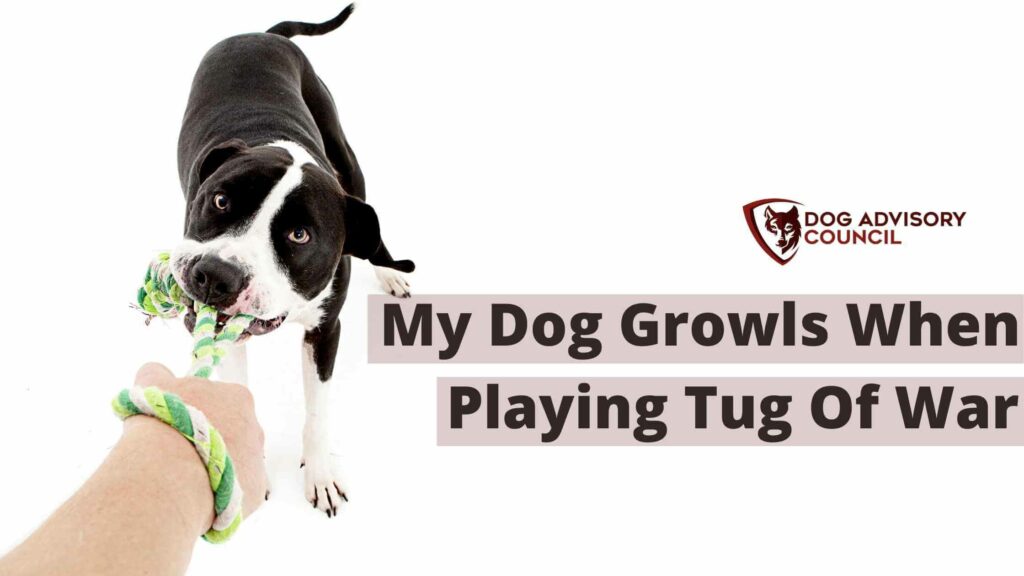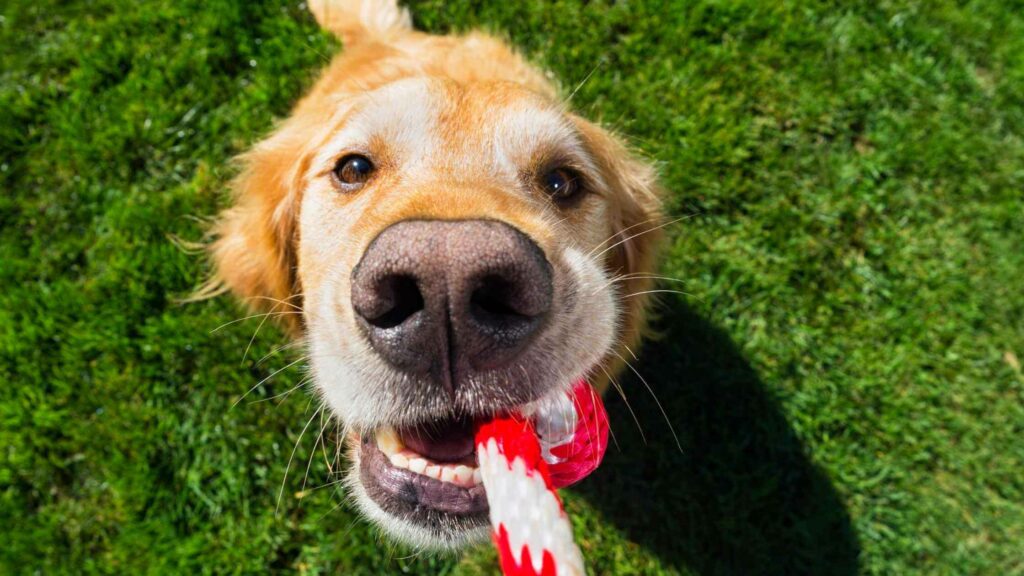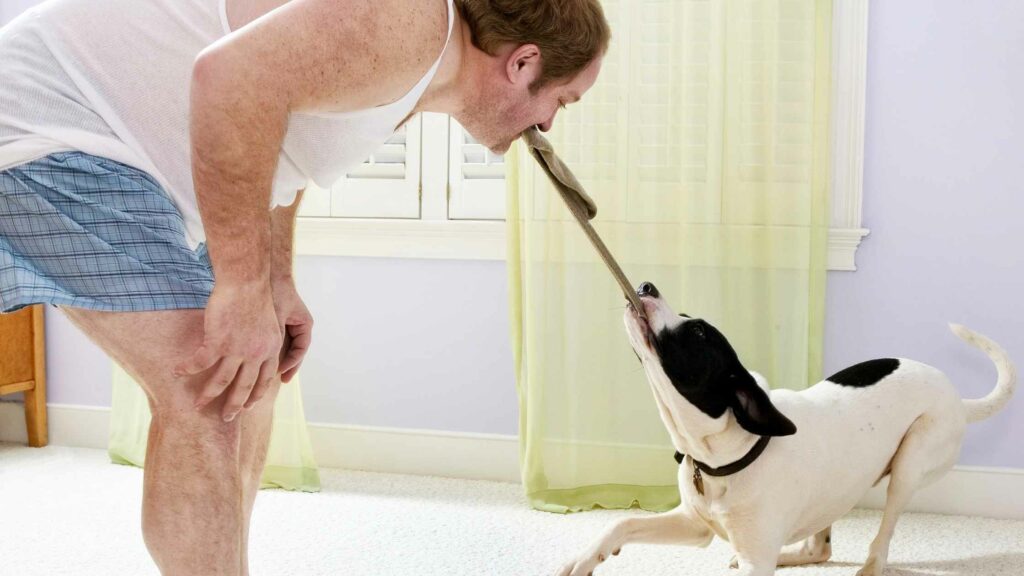
If your dog growls when playing tug of war this article is for you! Here’s what you need to know for a safe and fun playing experience!
Dogs will growl as a natural part of tug of war. This is naturally a predator-focused game, so growling is a natural reaction! However, dogs can get overexcited or overstimulated, so you’ll want to be careful not to encourage the behavior. For your and your dog’s safety, you’ll want to have proper controls in place for playing, releasing, and calming your dog.
Does tug of war cause aggression in dogs?
Tug of war is a popular game between dog owners and dogs. Some have it as a regular part of their dog’s play routine, and others see it as a rare activity. There are a lot of stigmas that playing tug of war can make your dog aggressive, but this is not the case. Tug of war can’t make our dog more aggressive but rather bring out any natural aggression that may or may not be aware of.
Dogs can get overstimulated by playing this game, and this will bring out the predator instinct that causes growling and potentially aggression. As discussed below, it’s important to always play within your bounds for everyone’s safety.
Why does my dog growl when I pull his toy?
Whether through tug of war or just pulling on their toy randomly, dogs can grumble or growl. This is the same predator instinct that causes them to actually growl when playing tug of war.
Back in the day, dogs would “fight” each other for food and other essential resources. They would growl at each other, even if it was lighthearted, to warn them off. Your dog is acting on that instinct and growling to let you know it’s their toy, and they don’t want you to pull it.
It can be lighthearted and playful, or it can be serious. We’ll show you below how to know which of these it is for everyone’s safety and comfort.
Is it normal for dogs to growl while playing?
It is perfectly normal and nothing to be concerned about if dogs growl when playing, particularly if they’re playing something as intense as tug of war. Curious as to how to know the difference between happy and warning growling? Keep reading.
If you notice that your dog is growling but is panting, sneezing randomly, and wagging their tail regularly, this is all happy growling. All these other actions show you that everything is okay, and your dog wants you to feel assured that they are playing with you.
If those behaviors stop, or your dog suddenly becomes more intensely focused on the game, it’s time to stop it. This is especially so if they get more intense in the game and even have their hackles go up (a sign of aggression).
Most pet parents can even hear a difference in the pitch and intensity of the growling since they know their dog better than anyone, technically.

Why should you play tug of war with your dog?
Despite some literature, tug of war is a wonderful game to consider playing with your dog most of the time. It has many tangible benefits, including:
- Bonding exercise
- Promoting healthy chewing
- Helping ease teething pain
- Providing a workout
- Giving them a healthy outlet for this instinct
When you are looking to bond and communicate with your dog, tug of war is one of the best games you can consider to enjoy all of these benefits.
You’ll still want to be sure that you are mindful of your dog’s body language and growling, however, so that it remains a safe and profitable exercise for you and your dog.
Why should you not play tug of war with your dog?
On the other hand, there might be some instances where you shouldn’t play tug of war with your dog. The first is if your dog is naturally aggressive. If your dog is a rescue or otherwise aggressive, even with you working hard to curb that instinct, tug of war can trigger it and cause a lot of frustration and possibly injury. Naturally, aggressive dogs will get no benefit from playing tug of war, so you’ll want to avoid it.
The other reason to avoid tug of war is that your dog isn’t known for behaving well. If they always seem to disobey you, particularly when playing. In that case, you’ll want to hold off on tug of war until you know that they’ll listen properly to you. Tug of war does require a lot of control, and misbehaving can end in disaster!
If you have questions about natural aggression and behavior, dog obedience training classes can be a great support to help you curb those issues with your dog’s health.
How long should you play tug of war with your dog?
Experts agree that you’ll want to keep tug of war games short with your dogs no matter how well-behaved and happy they are. Some recommend as short as 20 seconds, and others will say 5-10 minutes. When in doubt, go for 1-minute sessions with breaks in between.
The breaks help them “come down” from the high they feel and stay in control of their predator instincts. It also helps you draw out the bonding session longer.
If your dog is getting overexcited or overstimulated before the 1-minute mark, stop the game firmly and immediately and wait several minutes before starting it up again.
How can you tell if a dog is playing or being aggressive?
As we discussed above, you can determine playfulness by their other body language and your own understanding of their noises. However, you can also intervene at any point if you aren’t sure. Any time that you notice a game getting a bit too intense, even if they still seem to be in control, stop it. There’s no harm in doing it, and it’s always better to be safe than sorry!
Should I punish my dog for growling at me?
If your dog growls at you, don’t punish them. This can make them fearful or angry with you, furthering that aggressive behavior. Since growling is a biological instinct, disciplining them will do no good. You will, however, want to make sure that you stop the game immediately and “win” it. That is, you give them the command to stop the game, and you end up with the toy. Your dog will understand that you’ve won the resource and they have lost. It’s important to always “win” if your dog is growing or misbehaving.
This “winning” over your dog also reaffirms that you’re the alpha, and they’ll remember to listen to your commands. This is similar to how they lose a resource to a stronger dog back in their ancestral past.

How do you respond if your dog growls at you?
If your dog growls at you, determine if it’s fun or serious growling. If it’s fun growling, you can continue to play the game, but do it gently and don’t encourage them to get wound up. You’ll want to think about taking a break very soon, too, to prevent overstimulation.
If the growling gets stronger and the game gets too intense, stop the session with a command and don’t play tug of war with them for several minutes after. This keeps everyone in control and safe. Don’t let your dog bully you into playing early, either. Ignore any attempts they make to reengage you and keep the toy in your possession/out of their reach. Remember that you are in charge!
How do I get my dog to stop growling when playing?
It’s normal and okay to have your dog growl at you when playing, so the noise in and of itself is alright. If you want your dog to stop growling at you, however, then you will want to have a command already in place for “quiet” or “calm” or “stop” or “drop it,” etc. These will help your dog understand that their behavior is getting too wild.
How do I play tug of war safely with my dog?
Understanding how to play tug of war safely with your furry friend enhances the positives and reduces the negatives as much as possible! Here are some tips and tricks to guide you:
- Pick a durable toy
- Pick a wide open space
- Teach a release command
- Always start the game yourself
- Stop playing when growling or tugging gets intense
Pick a durable toy
This toy should be safe for your dog and your hands. Pick one that won’t break or snap and cause fear and pain on either side. Get one the right size for your dog, too, so both players have a fair advantage! Inspect the toy regularly and replace it as soon as you see it breaking down.
Pick a wide open space
When setting up your session, you’ll want to pick a safe space that will be damage-free and give you room to play and move around. Since games can get wild, even when you are in charge, it’s better to have lots of space around you both!
Teach a release command
Before you start to play, always have a designated command for releasing the toy. This is essential to stop the game immediately when it gets too intense. Keep in control of your dog, and make sure that you use this command enough to know your dog will respond when it really counts.
Always start the game yourself
While it’s sweet for the dog to want to start the game with you, you must only start it with your dog yourself. Ignore their attempts and take the toy away. Then, start it a few minutes later yourself. This signals to them that you are in control, not them.
Stop playing when growling or tugging gets intense
We’ve already talked about this several times, and for a good reason. Tug of war is a safe and fun game to play with your dog, but it can quickly get out of control with even the most experienced pet parent and sweetest dog. Stop the game as soon as you feel something is getting out of control and start it up again only after everyone, including yourself, has calmed down.
In general
Growling is a natural byproduct of tug of war due to a predator resource guarding instinct. You can safely play tug of war with your dog if the growling stays friendly and doesn’t get aggressive. You’ll want to focus on obedience training, staying in control, and stopping the games firmly as soon as something feels off to prevent injuries!
Tug of war is a great game to play that can mean your dog will growl at you. Understanding what it means and determining safe versus unsafe growling is essential. Share this with another dog lover to continue the fun!
